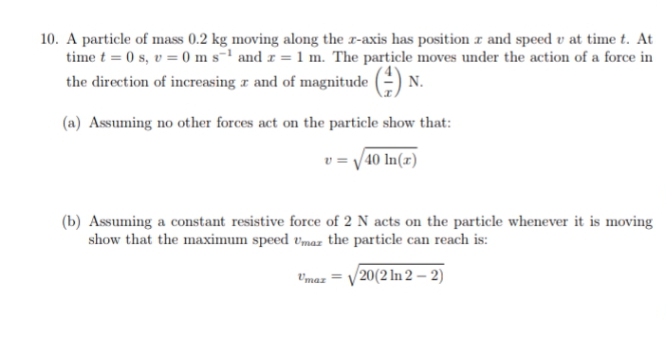10. A particle of mass 0.2 kg moving along the z-axis has position z and speed v at time t. At time t = 0 s, v = (0 ms- and z = 1 m. The particle moves under the action of a force in the direction of increasing z and of magnitude N. (a) Assuming no other forces act on the particle show that: v = /40 In(x) (b) Assuming a constant resistive force of 2 N acts on the particle whenever it is moving show that the maximum speed tmaz the particle can reach is: U'maz = /20(2 In 2 – 2)
10. A particle of mass 0.2 kg moving along the z-axis has position z and speed v at time t. At time t = 0 s, v = (0 ms- and z = 1 m. The particle moves under the action of a force in the direction of increasing z and of magnitude N. (a) Assuming no other forces act on the particle show that: v = /40 In(x) (b) Assuming a constant resistive force of 2 N acts on the particle whenever it is moving show that the maximum speed tmaz the particle can reach is: U'maz = /20(2 In 2 – 2)
Related questions
Question

Transcribed Image Text:10. A particle of mass 0.2 kg moving along the r-axis has position r and speed v at time t. At
time t = 0 s, v = 0 m s-1 and r = 1 m. The particle moves under the action of a force in
the direction of increasing a and of magnitude (-) N.
(a) Assuming no other forces act on the particle show that:
v = /40 In(x)
(b) Assuming a constant resistive force of 2 N acts on the particle whenever it is moving
show that the maximum speed vmaz the particle can reach is:
V'maz = /20(2 In 2 – 2)
Expert Solution
This question has been solved!
Explore an expertly crafted, step-by-step solution for a thorough understanding of key concepts.
This is a popular solution!
Trending now
This is a popular solution!
Step by step
Solved in 6 steps
